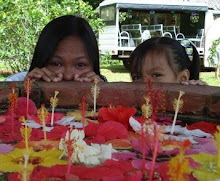main |
sidebar




About Me

- Claire Bear
- i have always been fascinated with the moon and the stars... usually a clown yet really deep... i am responsible but i break rules sometimes... a cry baby yet unbreakable... all I ever dreamed of is to see an apple tree, play hockey, own an island and go on a cruise... lastly, I'm a bagaholic, a reader and a movie buff.
Sharing True Love's Kiss at White Island, Camiguin
Blog Archive
-
▼
2008
(60)
-
▼
July
(15)
- Hip Hop ABS with Shaun T
- My First Camaron Rebosado!!! Yahoo!!!
- Reminiscing Childhood Memories at Merco
- Sleepers Over
- Syatong, Shatong, Chato
- Noong Araw...
- Mommy, Please Read Me This Book...
- Lunch at Gerry's Grill
- Mamma Mia!
- From My Childhood to Pia's
- Stranded at KM 1359
- John Hancock, the Newest Hero in Town
- Friday Blast
- Coffee & Laughter at Tata Benito's
- So Red Moon
-
▼
July
(15)
Links
Sunday, July 20, 2008
I grew up in the province and at a time where in our municipality (Maniki, Kapalong), the trisikad has not been even discovered yet, thus people has to walk wherever they want to go. Then, my favorite playmate was my Manong Raddy (my older brother), and I was kinda boyish then so wherever he'd go, I'd kept following him. What we most love doing together was catching huge frogs in our neighbor's pond...we'd let go of the frogs though.
I have to say we were lucky as kids cause we got to play all kinds of games which kids of these days no longer do (I don't think they even know how to play those kinds of games.) Our favorites were bulan-bulanay, dakpanay (habulan), taguanay (taguan), patintero, piko, holenay (marbles), tumbang preso, taguanay tukog sa yuta, palupad tabanog (kites), and syempre, playing shatong or syatong (chato in Tagalog).
This blog is all about how to play what I really miss playing....shatong!
Number of players: 2 teams with at least two players but you can play it as singles as well
Equipments:
* lots of open space (land) so you can dig an elongated shallow hole
* 1 long stick (about a foot and a half long and at least half an inch in diameter)
* 1 short stick (about 5 inches long and at least half an inch in diameter)

Mechanics:
THE CHANCE OF THE OPPONENT TO PLAY BASE. At the start of the game the base player places the short stick horizontally across the hole and position the long stick in the middle of the short stick and hits the latter as strong as he/she can to the direction of the opponent. If the opponent is able to catch the short stick, the base player loses the chance to advance further with the game and give the base to the former.If the opponent is unable to catch the flying short stick, he/she then collects the short stick and positions himself/herself to where it landed and throw it to the long stick placed horizontally on the hole. Hitting the long stick will give the opponent the chance to play the base.
MAKING A SCORE. If the opponent unable to get the two chances: catching the short stick and hitting the long stick, the base player then advances to the next stage of the game. The short stick is placed across the hole. The long stick dug in the hole positioned at the center of the short stick and hit the latter towards the opponent. The opponent gets the chance to play the base if he is able to catch the flying short stick. If not the opponent collects and positions himself/herself where the short stick landed and throw it to the base player. The base player then hits the short stick. The count starts measuring the distance where the short stick landed using the long stick if it is hit single, if double the short stick is used for the measurement. Hitting the short stick triple counts double the measurement. If the short stick landed near the hole and could not measure one count of the long stick, the opponent gets the chance to play the base.

THE CHANCE TO MAKE MORE SCORES. Advancing the game to another stage, the short stick is placed on the hole in slant position. The base player hits the tip of the short stick making it fly up on the air then hit it again to the direction of the opponent. The higher the short stick flies, the better the chance to hit it double or triple. The opponent will get the chance to play the base if he is able to catch the flying short stick. If not the count measuring the distance where the short stick landed is instituted using the principle of single, double, triple hit. If the short stick landed near the hole and could not measure one count of the long stick, the opponent gets the chance to play the base.
THE PUNISHMENT: While holding the sticks (the short and the long) one in each hand, winner will bat the shorter stick as far as he/she can. Loser then will shout SHAAATONG.... while running from the base to where the stick landed. If the loser takes a breath before reaching the destination then back to the base again.
DETERMINING THE WINNER. The sum of the measured distance in advance stage of the game determines the winner. The player who gets the least score will get the chance to enhance his/her vocal chords shouting shaaaaaaaaaaaaaatoooooooooooooooooooong.
One of these days, I'll surely teach Pia how to play this game so she'd experience how enjoyable it is.
1 Comment:
Subscribe to:
Post Comments (Atom)
Never lie, steal, cheat, or drink. But if you must lie, lie in the arms of the one you love. If you must steal, steal away from bad company. If you must cheat, cheat death. And if you must drink, drink in the moments that take your breath away. - - Hitch
Labels
- Abba (1)
- alamid (1)
- Anniepie (1)
- babies (1)
- beethoven (1)
- bella swan (1)
- Bigby's (1)
- birthday (1)
- bloggers eyeball (1)
- Blue Post (1)
- book (1)
- cafe (1)
- cafe med (1)
- camaron rebosado (1)
- carbonara (1)
- chato (1)
- chimes (1)
- Christopher Ribs (1)
- cinnamon (1)
- civet coffee (1)
- coffee (1)
- confession (1)
- Davao (1)
- DigitalFilipino (1)
- dimsum (2)
- Earth (1)
- Eddy's Grill Staition (1)
- edward cullen (1)
- fagioli (1)
- For One More Day (1)
- forget (1)
- forgive (1)
- gary valenciano (1)
- gerry's grill (1)
- grand slam pizza (1)
- hancock (1)
- Heath Ledger (1)
- hip hop abs (1)
- ice cream shakes (1)
- immortal beloved (1)
- jacob black (1)
- Janette Toral (1)
- joke (2)
- Kangaroo Coffee Company (1)
- kebab (1)
- kopi luwak (1)
- light repast (1)
- love letter (1)
- Lyra (1)
- mamma mia (1)
- Mandarin Tea Garden (1)
- marina tuna (1)
- Megan (1)
- merco (1)
- Mitch Albom (1)
- new moon (1)
- nightout (1)
- noong araw (1)
- opera (1)
- Oscars (1)
- parents (1)
- Paul Potts (1)
- penguins (1)
- pia (1)
- pia's masterpiece (1)
- pizza (1)
- Pizza Hut (1)
- PSP (1)
- rainbow brite (1)
- reading (1)
- red moon (1)
- restaurant (1)
- rice toppings (1)
- Sausage Pop N' Dip (1)
- shakey's (1)
- shatong (1)
- shaun t (1)
- sleepover (1)
- spare ribs (1)
- sprite (1)
- stranded (1)
- syatong (1)
- tata benito's (1)
- thank you girls (1)
- Twilight (1)
- vampire (1)
- will smith (1)
- Wind and Fire (1)

thanks for the info. we will be having our pinoy palaro here in malaysia and we will have syatong, patintero, tumbang preso. thanks for your post i was able to look at it and refreshed it. good memories of our childhood. i'm sure the children will have some fun playing syatong and the rest of the pinoy palaro. :)